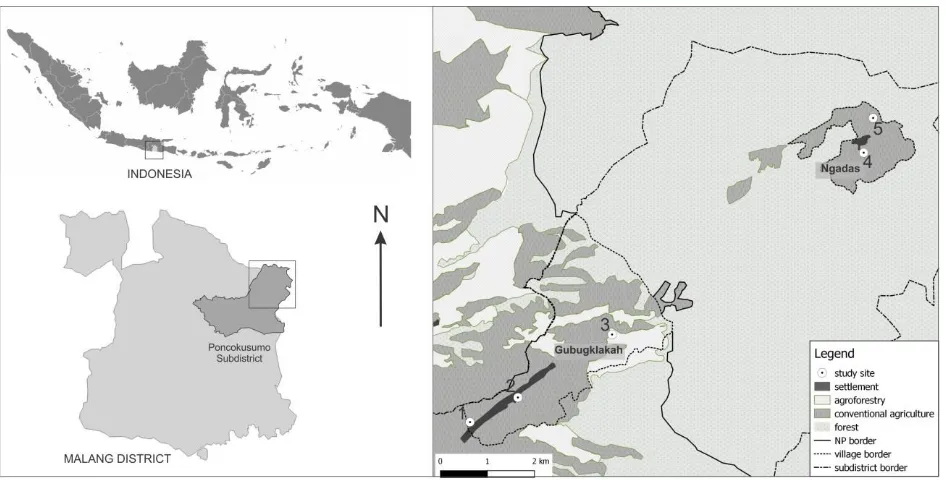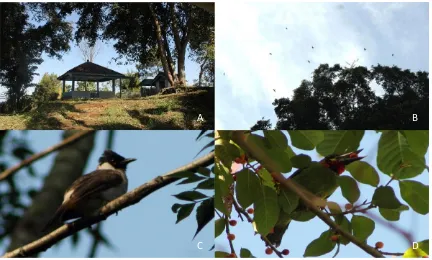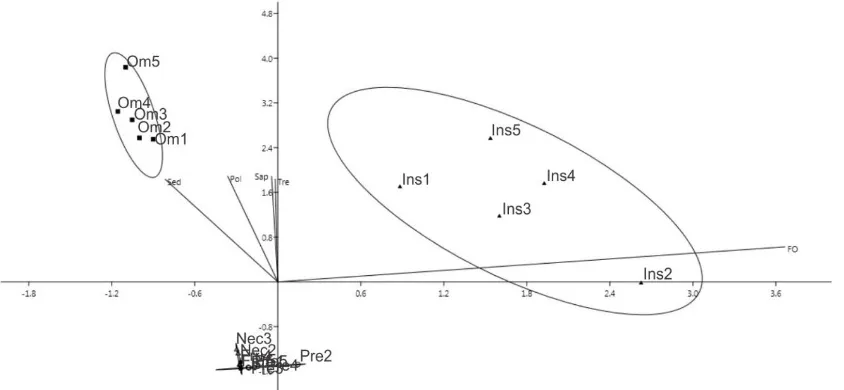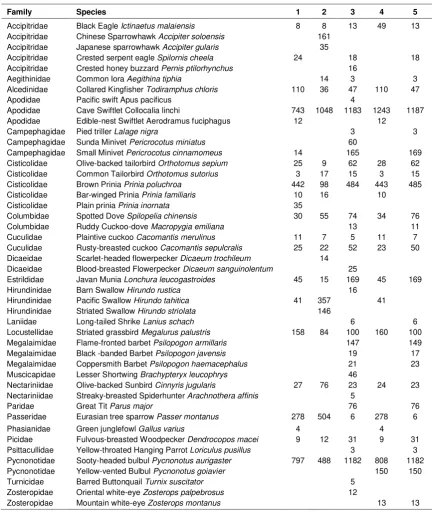61
individuals), pole (3440 individuals), perching on a tree (2782 individuals), and flying overs (6158 individuals). Most of th e insectivores were recorded flying over, where this character is owned by Cave Swiftlet. Figs, as an important component at the sacred area, provides many important component that could support the bird life and regeneration process. The presence of sacred tree also improving the relation between birds and plants, higher than those in the urban area or natural forest, and resulted a positive impact to the sustainable system of its surrounding agriculture.
Keywords: Bird, fig, Bromo Tengger Semeru, Sacred area
INTRODUCTION
The sacred place of Tengger is an evident of traditional conservation created by local wisdom. The knowledge of bioculture provides an immeasurable facts in understanding the occuring ecological processes [1] and provides an overview of local efforts in protecting the environment [2]. The presence of Tengger tribe plays an important role on the conservation efforts in Bromo-Tengger-Semeru National Park [3]. Tenggerese has a strong basic on implementing their role, as they
assertively holding onto the ancestor’s belief that
described by Sanggar pamujan and Dhanyangan on their spatial concept [4]. Sanggar Pamujan located on the highest ground of the village and Dhanyangan is a sacred place for protecting water resources. This place becomes a place for praying and serving sesajen (the sacred food) in Tengger belief [5, 6]. Both location is marked by the presence of an old Fig tree (Ficus sp.) that sacred by the Tengger tribe. Moreover, the Fig tree becomes the habitat for some species of birds. The
canopy’s cover reserves water [7, 8], insects, and
fruits as food for bird [9] and creates an interesting relation as a microhabitat.
In this study, we investigated the bird’s composition and preference on visiting the sacred Figs and its adjacent area in two villages of Tengger
Correspondence address:
Agung Sih Kurnianto
Email : agung.sih.kurnianto@gmail.com
Address : Brawijaya University, Jl. Mt. Haryono 169 Malang 65145, Indonesia
tribe. The bird diversity could represent the quality of environment and microhabitat visited by the birds [9]. The surrounding agricultural and settlement area are very susceptive on suppresing the bird community [10-13], or indeed synergize together [5-6, 14]. Therefore, this study becomes a great opportunity to record the relationship between plant-bird-human in the sacred tree of Tengger as a microhabitat.
MATERIAL AND METHOD
The survey area was located in two Tengger villages: Gubugklakah and Ngadas, Poncokusumo District, Malang Regency, East Java Province, Indonesia. Survey was conducted in May (dry season) and September (wet season), 2016. Five survey points were chosen to represent each microhabitat in three sacred sites that adjacent to agricultural and settlement area: Dhanyangan and Sanggar Pamujan in Gubugklakah village (Figs crown volume approximately = 1802 m3, 1701 m3),
Sanggar Pamujan in Ngadas (Figs crown volume approximately = 1781 m3) (Fig.1). As comparation,
we also surveyed two sites that is not sacred by the tribe at the conventional field in Gubugklakah and Ngadas village. We applied point count method [15] with 4 observers at every cardinal point in each location to avoid repeated record (n observers=20).
62
Figure 1. Map of study area. The numbered circles show the point count and clasification of sites. Key: 1= Gubugklakah conventional agriculture; 2=Dhayangan of Gubugklakah; 3=Sanggar Pamujan of Gubugklakah; 4=Ngadas Conventional agriculture; 5=Sanggar Pamujan of Ngadas.
The point count was used as the starting point for vegetation analysis in each sites, with four cardinal point (length = 20 m). The result was visualized by the representment of the greatest usage of vegetation composition by the birds according to 4 classification: seedling (high: 0-1.5
m), sapling (high≥1.5), pole (diameter: 10-20 cm), tree (diameter>20 cm), and fly overs. Survey was conducted everyday, started from 6 to 9 am as the highest diurnal activities of the birds, and avoided the rain, fog, and wind. We recorded the species, total individual, and behaviour that was observed visually.
The identification and inventarisation were classified according to the diet specialization and observation: mammals and birds (predator), insects and reptiles (insectivores), insects and plants (omnivores), and fruits (frugivores) [16]. The preference form and classification were represented by biplot analysis using PAST 3.14 Software. We used Nikon Aculon A30 8X25 binoculars to identify the bird and Canon EOS 1100D+300 mm canon lens to documenting. Identification was conducted by using field guide book [16].
RESULT AND DISCUSSION
We recorded 16154 individual birds in 35 days of observation, consisted of 46 species and 24 families. These consist of 362 predators, 9452 insectivores, 6029 omnivores, 278 nectarivores, and 33 frugivores. The observed bird were
recorded utilizing seedling (652 individuals), sapling (3122 individuals), pole (3440 individuals), perching on a tree (2782 individuals), and flying overs (6158 individuals).
Insectivores dominated the result of this study. Most of the insectivores were recorded flying over (57,17% of total insectivores) (Figure 2), where this character is owned by Cave Swiftlet (5404 individuals). The other insectivores, such as Brown Prinia and Striated Grassbird, also found in smaller percentage, approximately 20.65% and 6.36% respectively. Both species and the other insectivore specialist were observed using various vegetation classification, including seedling, sapling, pole and tree, with the percentage of 2.02%, 3.65%, 12.65%, and 11.24% respectively.
The Cave Swiftlet were found continuously flying in a circle, right above the figs tree (Figure 2A). Cave Swiftlet filters the insects by using its wide mouth as it flies [17]. Its unique anatomy, no gizzard in the esophagus, makes it continuosly filters the insects and immediately digests it [18]. Other than insects, Cave Swiftlet also interested on the water resources located under Dhanyangan. Cave Swiftlet has a unique behavior of drinking the raindrop or direct contact with water surfaces while flying [19]. Their behavior make them usually seen flying near the open water surface or flying in rainy or windy condition, in contrast with the other birds that avoid the physiological disadvantage when flying in the bad weather [20-21].
63
Figure 2. a) Sanggar Pamujan Gubugklakah; b) A flock of Cave Swiftlet Collocalia linchi; c) Sooty-headed bulbul Pycnonotus aurigaster; d) Black-banded Barbet Psilopogon javensis eating the fig fruit.
Omnivore was dominated by Sooty-headed Bulbul (73.92%). Although most of the omnivores were found using pole (35.38%), but they also utilizing the other vegetation equally, including seedling, sapling and tree with the percentage of 7.67%, 30.38%, and 26.47% respectively. Sooty-headed bulbul hunts insects in a group at agricultural area that (Figure 2C) represented by seedling, sapling, and pole vegetation. The interesting fact was when the figs tree became fruitful, they would appear at tree classification with the community of frugivore bird (Figure 2D), which is the rarest specialist found during the observation (0.20%). Sooty-headed bulbul also observed while mating or building a nest on figs tree (location 2). There was no competition aggression during the fruitful season of Figs tree. The other specialist, nectarivore, was only found in a small community during the observation, approximately 1.72%. Nectarivores were mostly found while visiting pole (36.69%) and tree (30.37%).
Sooty-headed bulbul showing a great utilization of figs tree, such as mating, nesting, hunting, and socializing. They are mostly attracted with the figs fruit that temporally appear, in addition, as well as insects [9, 22-23]. However, their varies role and wide distribution on every type of vegetation make them able to compete with other specialist, such as insectivore and frugivore (Figure 3).
The observed bird was found to be higher in the sacred area with the average of 3319.67, or 3.46% higher than those found in the non-sacred area. The average of visiting time on 5 survey points during the 35 days of observation were 82.03±23.26 , 90.63±29.07 , 87.88±34.90 , 94.94±27.51 , 106.31±47.90, respectively. All birds found on the non-sacred area was also found on the sacred area. There was no feeding activity observed on the non-sacred tree, while the other activities were commonly observed, such as chirping and preening.
Figs, as an important component at the sacred area, provides many important role that could support the bird life and regeneration process [9]. Sooty-headed bulbul is an example of birds that utilizing Figs on suppporting their life until reproduction stage. Figs is chosen by Sooty-headed bulbul according to their preference on a tree that could support their offspring life, such as safety and feed availability [24]. The interesting fact is they undertake most of their avtivities on other vegetation that characterized as agriculture near the sacred area. This represents that the presence of sacred area is very profitable for the surrounding agriculture. The visit of insectivorous and omnivorous birds in all vegetation type represents their role in controlling insect pests on agriculture [13, 25] and helping on spreading the seeds [26] on the vacant and unproductive land.
B
D
64
Figure 3. Biplot analysis of birds specialist prefention to vegetation type. The bird specialization was arranged in a code: Pre (Predator); Ins (Insectivore); Om (Omnivore); Nec (Nectarivore); Fru (Frugivore). Number at the dots represents the specialization on the survey sites.
The presence of sacred tree also improving the relation between birds and plants, higher than those in the urban area [13, 27] or even natural forest [9]. The competition among the urban niche users is very intense, while the resources is limited and reduced. Thus becomes one of the reasons that the bird community is highly susceptible. On the other hand, the natural forest is threatened by land degradation, including the figs tree that has long been known in supporting the bird life. The sacred tree has become a microhabitat that protected by culture. In addition, the ecological role and the protection from the sanctity itself have placed the tree as a sacred thing.
Figs takes an important role in the concept of Tengger culture. Every sacred place in Tengger is certainly has Figs tree as the representation of
God’s guarding in the society life and the nature.
Therefore, the leaves of figs become an important part for wedding and traditional ceremony: Selamatan and Entas-entas [4]. Figs also known to have a role as water lifter [7], so that the tribe with their local knowledge conserving this tree intentionally, such as planted it near the water resources (Dhanyangan) and upland (Sanggar). This concept has worked by maintaining the water supply for the agriculture and settlement area located lower than the sacred figs. Interestingly, all that local knowledge has indirectly conserve the figs tree and the components inside the microhabitat to be able to work harmoniously.
CONCLUSION
We found that the sacred tree of Tengger tribe has a great potential as an effective conservation area. The presence of figs tree in a sacred location has given a protection and has conserved the bird
diversity. This phenomenon is not easily to be found in other region and resulted a positive impact to the sustainable system of its surrounding agriculture. This becomes an important point on arranging the spatial policy, where maintaining the sacred tree would broaden the success of bird conservation and Tengger agriculture.
ACKNOWLEDGEMENT
We thank all the colleagues and students of biodiversity laboratory, Graduate Program of Brawijaya University. We also grateful to the Tengger tribe in Gubugklakah, Ngadas, for the accompaniment and assistance in the field. Special thanks to Perhutani (Persero), ranger of Bromo Tengger Semeru National Park, and Poncokusumo sub-district government for giving the permission, sharing information, and the accompaniment.
REFERENCES
[1]. O’Neill, A.R., H.K. Badola, P.P Dhyani,S.K. Rana. 2017. Integrating ethnobiological knowledge into biodiversity conservation in the Eastern Himalayas. Journal of Ethnobiology and Ethnomedicine. 13: 1-14. [2]. Alves, R.R.N., R.C.L. Leite, W.M.S. Souto,
D.M.M. Bezezza, A. Loures-Riberion. 2013. Ethno-ornithology and conservation in the semi-arid Caatinga of northeastern Brazil. Journal of Ethnobiology and Ethnomedicine. 9: 1-12.
[3]. Hakim, L. (2011). Cultural Landscapes of the Tengger Highland, East Java. In Landscape Ecology in Asian Cultures (pp. 69-82). Springer Japan.
65 performance of grown in the Purwodadi
Botanic Garden. Journal of Tropical Life Science. 7: 40-47.
[9]. Sreekar R., N.T.P. Le, R.D. Harrison. 2010). Vertebrate assemblage ata fruiting fig (Ficus caulocarpa) in Maliau basin, Malaysia. Tropical Conservation Science. 3: 218-227. [10]. Dunn, J.C., K.C. Hamer, T.G. Benton. 2015.
Anthropogenically-Mediated Density Dependence in a Declining Farmland Bird. PLoS ONE.10(10): e0139492.
[11]. Harms, T.M., K.T. Murphy, X. Lyu, S.S. Patterson, K.E. Kinkead, S.J. Dinsmore. 2017. Using landscape habitat associations to prioritize areas of conservation action for terrestrial birds. PLoS ON.E 12(3): e0173041.
[12]. Guilherme, J.L., P.H. Miguel. 2013. Adaptation of Bird Communities to Farmland Abandonment in a Mountain Landscape. PLoS ONE. 8(9): e73619.
[13]. Seress, G., A. Liker. 2015. Habitat urbanization and its effects on birds. Acta Zoologica Academiae Scientiarum Hungaricae. 61: 373-408.
[14]. Cox, D.T.C., K.J. Gaston. 2016. Urban Bird Feeding: Connecting People with Nature. PLoS ONE. 11(7): e0158717.
[15]. Hostetler, M.E., M.B. Main. 2000. Point Count Method for Surveying Birds. Florida Monitoring Program. IFAS Extennsion. Florida.
[16]. Mackinnon, J., K. Phillipps, B. van Balen. 2010. Burung-burung di Sumatera, Jawa, Bali, dan Kalimantan. Burung Indonesia. Bogor.
[17]. Lourie, S.A., D.M. Tompkins. 2008. The diets of Malaysian swiftlets. Ibis. 142: 596. [18]. Novelina, E.S., A.S. Satyaningtijas, S.
Agungpriyono, H. Setijanto, K. Sigit. 2009. Morphological study of the Oesophagus and Stomach of the Cave Swiftlets (Collocalia
radar and visual analyses. American Zoologist. 31: 187-204.
[22]. Sanitjan, S., J. Chen. 2009. Habitat and fig characteristics influence the bird assemblage and network properties of fig trees from Xishuangbanna, south-west China. Journal of Tropical Ecology. 25: 161– 170.
[23]. Bhatt, D., A. Kumar. 2001. Foraging ecology of Red-vented Bulbul Pycnonotus cafer in Haridwar, India. FORKTAIL. 17: 109–110. [24]. Wee, Y.C. 2009. Observations on the
behaviour of the yellow-vented bulbul Pycnonotus goiavier (Scopoli) in two instances of failed nesting. Nature in Singapore. 2: 347-352.
[25]. Speakman, J.R., J. Rydell, P.I. Webb, J.P. Hayes, G.C. Hays, I.A.R. Hulbert, R.M. McDevitt. 2000. Activity patterns of insectivorous bats and birds in northern Scandinavia (69°N), during continuous midsummer daylight. Oikos Journal. 88: 75– 86.
[26]. Pizo, M.A. 2004. Frugivory and habitat use by fruit-eating birds in a fragmented landscape of southeast brazil. Ornitologia neotropical. 15: 117-126.
[27]. Scochat, E., S. Lerman, Fernández-Juricic. 2010. Birds in urban ecosystems: population
dynamics, community structure,
66
Appendix
Table 1. A complete list and individu number of birds in 5 study sites. Keys: 1=conventional agriculture of Gubugklakah, 2=Dhanyangan of Gubugklakah, 3=Sanggar Pamujan of Gubugklakah, 4=conventional agriculture of Ngadas, 5=Sanggar Pamujan of Ngadas
Family Species 1 2 3 4 5
Accipitridae Black Eagle Ictinaetus malaiensis 8 8 13 49 13
Accipitridae Chinese Sparrowhawk Accipiter soloensis 161
Accipitridae Japanese sparrowhawk Accipiter gularis 35
Accipitridae Crested serpent eagle Spilornis cheela 24 18 18
Accipitridae Crested honey buzzard Pernis ptilorhynchus 16
Aegithinidae Common Iora Aegithina tiphia 14 3 3
Alcedinidae Collared Kingfisher Todiramphus chloris 110 36 47 110 47
Apodidae Pacific swift Apus pacificus 4
Apodidae Cave Swiftlet Collocalia linchi 743 1048 1183 1243 1187
Apodidae Edible-nest Swiftlet Aerodramus fuciphagus 12 12
Campephagidae Pied triller Lalage nigra 3 3
Campephagidae Sunda Minivet Pericrocotus miniatus 60
Campephagidae Small Minivet Pericrocotus cinnamomeus 14 165 169
Cisticolidae Olive-backed tailorbird Orthotomus sepium 25 9 62 28 62
Cisticolidae Common Tailorbird Orthotomus sutorius 3 17 15 3 15
Cisticolidae Brown Prinia Prinia poluchroa 442 98 484 443 485
Cisticolidae Bar-winged Prinia Prinia familiaris 10 16 10
Cisticolidae Plain prinia Prinia inornata 35
Columbidae Spotted Dove Spilopelia chinensis 30 55 74 34 76
Columbidae Ruddy Cuckoo-dove Macropygia emiliana 13 11
Cuculidae Plaintive cuckoo Cacomantis merulinus 11 7 5 11 7
Cuculidae Rusty-breasted cuckoo Cacomantis sepulcralis 25 22 52 23 50
Dicaeidae Scarlet-headed flowerpecker Dicaeum trochileum 14
Dicaeidae Blood-breasted Flowerpecker Dicaeum sanguinolentum 25
Estrildidae Javan Munia Lonchura leucogastroides 45 15 169 45 169
Hirundinidae Barn Swallow Hirundo rustica 16
Hirundinidae Pacific Swallow Hirundo tahitica 41 357 41
Hirundinidae Striated Swallow Hirundo striolata 146
Laniidae Long-tailed Shrike Lanius schach 6 6
Locustellidae Striated grassbird Megalurus palustris 158 84 100 160 100
Megalaimidae Flame-fronted barbet Psilopogon armillaris 147 149
Megalaimidae Black -banded Barbet Psilopogon javensis 19 17
Megalaimidae Coppersmith Barbet Psilopogon haemacephalus 21 23
Muscicapidae Lesser Shortwing Brachypteryx leucophrys 46
Nectariniidae Olive-backed Sunbird Cinnyris jugularis 27 76 23 24 23
Nectariniidae Streaky-breasted Spiderhunter Arachnothera affinis 5
Paridae Great Tit Parus major 76 76
Passeridae Eurasian tree sparrow Passer montanus 278 504 6 278 6
Phasianidae Green junglefowl Gallus varius 4 4
Picidae Fulvous-breasted Woodpecker Dendrocopos macei 9 12 31 9 31
Psittacullidae Yellow-throated Hanging Parrot Loriculus pusillus 3 3
Pycnonotidae Sooty-headed bulbul Pycnonotus aurigaster 797 488 1182 808 1182
Pycnonotidae Yellow-vented Bulbul Pycnonotus goiavier 150 150
Turnicidae Barred Buttonquail Turnix suscitator 5
Zosteropidae Oriental white-eye Zosterops palpebrosus 12



